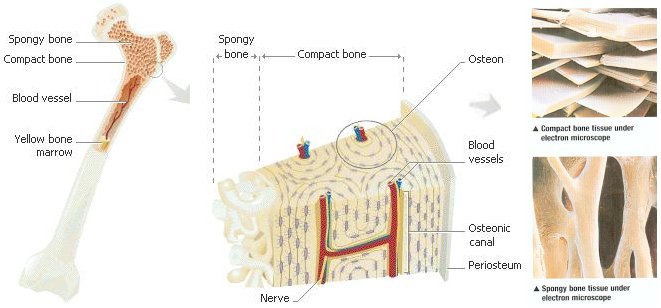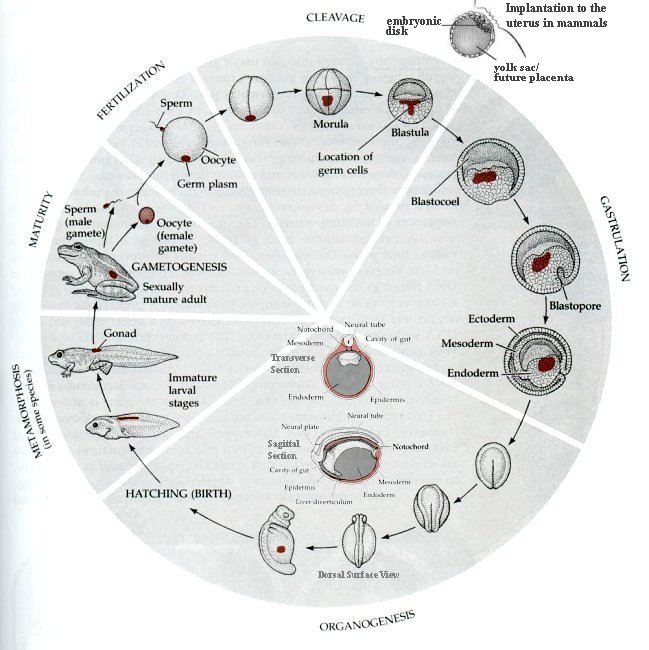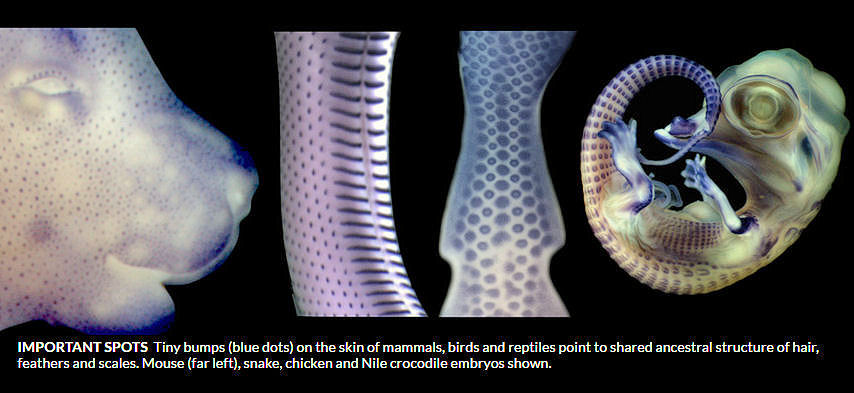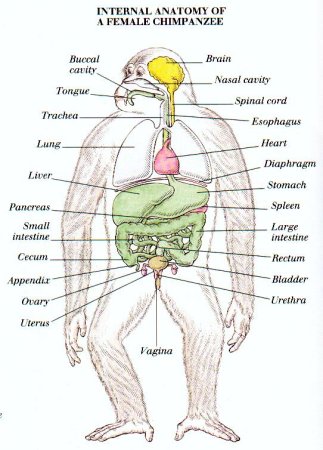

| Home Page | Overview | Site Map | Index | Appendix | Illustration | About | Contact | Update | FAQ |
 |
 |
the only chordate feature retained by the adult. The larva of the tunicate, however, has a tadpole shape and possesses the three chordate characteristics. It has been suggested that such a larva may have become sexually mature without developing the other adult tunicate characteristics, and may have evolved into a fishlike vertebrate similar to the lancelet, which is a chordate that shows the three chordate characteristics as an adult. |
Figure 19a Vertebrates |
Figure 19b Protochordates |
 |
|
Figure 19c Limbs |
sometimes absent). There is a fundamental design in the skeleton of all vertebrates. Humans, bats, lizards, and whales are all just variations on a theme (see for example the common pattern of limbs for some vertebrates in Figure 19c). |
 |
Bone is the major component of the skeletons in adult vertebrates. It is composed of both living tissues, such as bone cells, fat cells, and blood vessels, and nonliving materials (such as collagen) secreted by the bone cells called osteoblasts into the inter-cellular space. The collagen fibers are coated with a calcium phosphate salt, making it strong without being brittle. As shown in Figure 19d, a bone can be divided into four parts: |
Figure 19d Bone [view large image] |
1. Periosteum - This fibrous membrane is the outer layer of the bone. It is rich with blood vessels and nerve endings and it ends at the edge of the joint area or where the ligaments and the tendons insert themselves. |
 |
An important contribution to the shape of animals with backbones is the number of vertebrae (bones in spinal column) that make up the structure. While human has only 33, snakes have more than 300, with some species having more than 500. Vertebrae develop from segments of tissue called somites, which form, one after another, in a head-to-tail sequence in the embryo (diagram a, Figure 19e). They bud off from the "head" end of the presomitic mesoderm (PSM), an immature tissue fated to generate the somites. This budding is regulated by a "clock-and-wavefront" |
Figure 19e Somitogenesis [view large image] |
model. In snakes, the clock genes seems to express 4 times faster than in shorter-bodies animal (such as mice), leading to many more, though smaller, somites (see diagram b in Figure 19e). |
 |
Two types of eyes had developed since the Cambrian explosion. The arthropods adopt compound eyes, which is suitable for small animals but becomes too bulky for larger ones in the vertebrate kingdom. The camera-style did not come "ready-made" as claimed by creationists and intelligent design proponents. Studies in the 2000's reveal that about 500 million years ago camera-style eyes first appeared as a simple light sensor for regulating circadian rhythms, as well as seasonal activities such as feeding and breeding. The primitive retina with two layers can detect light but cannot form image. Figure 19f shows the evolutionary path by comparing different species (from primitive hagfish to human in horizontal row) and by embryonic development (as shown in vertical columns). It also shows that evolution does not always produce perfect structures as the photoreceptors are |
Figure 19f Evolution of Eye [view large image] |
blocked by two layers of cells. However, when octopuses and squids took another evolutionary path independently, their camera-style eyes do not suffer such deficiencies. |
 |
1. Cleavage - a stage of extremely rapid mitotic divisions wherein the zygote cytoplasm is divided into numerous smaller cells. By the end of cleavage these cells generally form a fluid-filled sphere known as blastula. 2. Gastrulation - The cells in the blastula undergo dramatic movements wherein they change their positions relative to one another. As a result, the typical embryo contains three germ layers - the etoderm in the outside, the mesoderm in the middle and the endoderm is the innermost layer. The invagination of cells is something like poking a curved finger into a balloon. 3. Organogenesis - The cells interact with one another and rearrange themselves to produce the bodily organs. In vertebrates, the mid-dorsal ectodermal cells fold to form the neural tube with the notochord laying under. Also during this stage certain |
Figure 19g Embryonic De- velopment [view large image] |
cells such as the blood, lymph, pigment, and the gamete migrate from their place of origin to the final location. 4. Gametogenesis - As shown in Figure 19g, a portion of egg cytoplasm gives rise |
 |
 |
lungs for gas exchange instead of gills. It is believed that the gill arches have been modified to become the jaw as shown in Figure 20a. Further modification of these gill arches can be traced from an embryo to an adult (in humans as shown in |
Figure 20a Evolution of Jaws [view large image] |
Figure 20b Evolution of Gill Arches [view large image] |
Figure 20b). The origins of jaws, ears, larynx, throat, bones, muscles, nerves, and arteries can all be found in these gill arches. |
 |
 |
 |
Meanwhile in 2015, a frilled shark believed to be around in the Cretaceous Period about 80 million years ago is caught off South West Australia. This 6-foot-long fish has 300 teeth in 25 rows (Figure 21c). |
Figure 21a Fishes |
Figure 21b Living Fossils [view large image] |
Figure 21c Frilled Shark |
 |
fossils with living fossils, detailed studies of the external structures, the relict distribution, the taxonomic diversity, and the DNA sequence of the living fossils indicate that the living fossils are not exactly the same of the corresponding fossils. As shown in Figure 21d, the horseshoe crab and ginkgo tree are now spread all over the world, the horseshoe crab has also diversified to four different species. These living fossils and the other examples in Figure 21d demonstrate that changes did occur beyond the apparent forms. Thus, the superficial similarity in appearence is deceptive. Actually all current organisms retain some features of the ancestor, be it in DNA sequence or form. For example, the homeobox genes are ubiquitous in multicellular organisms; the advanced invertebrates and all vertebrates posses similar animal features including body plan, body symmetry etc. These characteristics had been developed hundreds of million years ago. It is from the high degree of resemblance in external morphology that prompted Darwin to coin the term "living fossil" arbitrarily. It seems that besides blind luck - like surviving a cataclysmic extinction, or being first to move into a new niche - it is often a key innovation which renders living fossils successful in persisting for long stretches of time. |
Figure 21d Truth about Living Fossils |
 |
and fibrous and more difficult to break down into usable components. The function of the pyloric caeca is not entirely understood, but it is known to secrete enzymes that aid in digestion, may function to absorb digested food, or do both. The liver has a number of functions. It assists in digestion by secreting enzymes that break down fats, and also serves as a storage area for fats and carbohydrates. The liver is also important in the destruction of old blood cells and in maintaining proper blood chemistry, as well as playing a role in nitrogen (waste) excretion. Figure 22a shows the internal anatomy of a common fish. |
Figure 22a Fish Anatomy |
 |
 |
fertilization occurs. The zygote develops into a swimming larva that can fend for itself until it develops into the adult form.
A 2014 research report indicates that the long-extinct fish called placoderms (the armour-plated creatures - our ancient ancestors) in the Silurian Period had internal sex by a bony 'claspers'. Somehow the practice had been reverted back to external fertilization. The act of copulation was re-invented later by the land animals (see Figure 22c) - a reversal previously thought to be evolutionarily improbable. |
Figure 22b Ancient Sex [view large image] |
Figure 22c Evolution of Intromittent Organ [view large image] |
 |
|
Figure 23 Amphibians |
 |
Man has 12. Similarly, the frog has only 10 pairs of spinal nerves. Man has 30 pairs. Two simple holes make up the nostrils for the frog. There are complex valves but no long nasal passages as there are in man. The frog's sense of smell is registered by olfactory lobes. These make up the forward portion of the brain. The eye is crude. Its fixed lens cannot change its focus. Poorly developed eyelids do not move. To close its eye, the frog draws the organ into its socket. A third eyelid, or nictitating membrane, may be drawn over the pulled-in eyeball. There is no external ear. Both eardrums, or tympanic membranes, are exposed. There is only one bone in the frog's middle ear. The human middle ear contains three bones (malleus, incus, and stapes in the ossicles). As in man, semicircular canals help to maintain body balance. |
Figure 24a Frog Anatomy |
 |
sound-generating mechanisms and organs for acoustic perception. Fishes are able to produce different types of sounds and to perceive acoustic signals of different frequencies, temporal patterns and intensities. They possess inner ear and a few have rudimentary middle ear (the ossicles). Human diving experience indicates that sound wave in water can only be perceived through bone conductivity via vibration of the bones of the skull. The efficiency of this method of sound wave detection is 40% weaker than air conductivity in land animals and it lacks sufficient orientation to identify the direction of the audial source. It is not accidental that the full apparatus of ear developed only after animals making a living on land. Figure 24b traces the development of the stapes from the gill arches in the upper jaw of fish to the stapes in amphibian. The same figure also shows that the malleus and incus come from the lower jawbones of the reptile. The transformation sequence is supported by fossils bearing a continuum of forms as shown. The construction of the mammalian middle |
Figure 24b Ear Bones Evolution [view large image] |
ear allows detection of higher frequency sounds. The distance between the two ears enables its owner to discern direction of the sound source (because the sound speed in air is lower than that in water). See also evolution of the inner ear. |
 |
|
Figure 24c Cutaneous Gas Exchange [view large image] |
frog known to science without lungs and joins a short list of amphibians with this unusual trait, including a few species of salamanders and a wormlike creature known as a caecilian. |
 |
|
Figure 24c Reptiles |
by exposing themselves to the sun if they need warmth or by hiding in the shadows if they want to cool off. |
 |
lizards with a bladder, it is connected to the cloaca by a short urethra. Urine passes into the cloaca and then into the urinary bladder, if present, or into the distal colon where water resorption occurs. The cloaca typically consists of 3 chambers. The coprodeum is the most cranial and receives fecal material and urinary wastes. The urodeum is the middle section and receives genital secretions and urinary wastes |
Figure 24d Lizard Anatomy |
from the urogenital ducts. The caudal proctodeum acts as a reservoir for fecal and urinary wastes before they are excreted. This also is the location of the openings of the musk glands. |
 |
It is replaced by swelling/pressure from diffusion of lymph between new and old layers. The surface scales can be in varied form. In some lizards the scales are small and grainlike, while in others they are large and plate- like. The scales may be smooth or they may have little ridges called keels or they may even have developed into spines. A 2016 research shows that scales, feathers and hairs develop from the same group of placode cells (the dark blue spots in Figure 24e) suggesting a common origin of these diverse features. |
Figure 24e Scales, Feathers, Hairs, Common Origin [view large image] |
 |
fertilization has occurred, the egg is covered by a protective, leathery shell and is laid in an appropriate location. The shelled egg made development on land possible and eliminated the need for a swimming-larva stage during development. It provides the developing embryo with oxygen, food, and water; it removes nitrogenous wastes; and it protects the embryo from drying out and from mechanical injury. This is accomplished by the presence of extraembryonic membranes (Figure 24f). |
Figure 24f Membranes |
It is discovered in 2011 that an obscure African lizard called T. ivensii does possess a true placenta used to be monopolized by mammals. Cells on the outside of the embryo send out extensions that burrow between the cells of the oviduct wall and |
 |
Birds are characterized by the presence of feathers, which are actually modified reptilian scales. There are many orders of birds, including birds that are flightless (ostrich), web footed (penguin), divers (loons), fish eaters (pelicans), waders (flamingos), broad billed (ducks), birds of prey (hawks), vegetarians (fowl), shorebirds (sandpipers), nocturnal (owl), small (hummingbirds), and songbirds, the most familiar of the birds. Some of them are showed in Figure 25a. Nearly every anatomical feature of a bird can be related to its ability to fly. Figure 26a shows the anatomy of a common bird. |
Figure 25a Birds |
 |
|
Figure 25b Warm Bloodedness |
lizard, it also shows the temperature differences from different parts of the body. The 37 oC is measured in the mouth, it is 37.4 oC in the rectum, and 36.7 oC in the armpit. |
 |
 |
 |
reproduction occur in birds: some birds incubate eggs for a long time - chicks are born with feathers and can walk/swim (ducks); while others incubate eggs a short time - chicks are born featherless and helpless (robins). The process of making egg is illustrated in Figure 26b; while the structure of a chicken egg is displayed in Figure 26c together with a description of its various components in Table 02. |
Figure 26a Bird Anatomy |
Figure 26b Making Egg |
Figure 26c Chicken Egg |
| Component | Composition | Function(s) |
|---|---|---|
| Yolk | Protein and fat | Provision of nourishment |
| Albumen | Protein and water | Provide additional nutrition and protection |
| Amniotic fluid | Water and other materials | Protection and aiding the growth of the fetus |
| Allantois | Nitrogenous waste | Collection of waste |
| Embryonic disk | Cells of the embryo | The developing embryo |
| Chalaza | Part of egg white, 2 spiral bands of tissue | Stabilizing the yolk |
| Chorion | Two layers of cells | Membranes for gas exchange |
| Air sac | Air | Provide oxygen for baby chick just before hatching |
| Shell | Protein matrix lined with calcium carbonate | Protective outer cover |
 |
The chief characteristics of mammals are hair and mammary glands that produce milk to nourish the young. Human mammary glands are called breasts. Mammals are classified according to their means of reproduction: there are egg-laying mammals called monotremes such as the duck-billed platypus; mammals with pouches for immature embryos are the marsupials such as the kangaroos; while the placental mammals are the majority of living mammals. Figure 27a shows just a few of these animals. Table 03 lists the 18 orders of living placental mammals. They are classified largely according to the mode of locomotion and how they get their food. Figure 28 illustrates a cat's anatomy, which is very similar to the human's. See "Age of Animals" for "mammal characteristics and comparison with other vertebrates". |
Figure 27a Mammals |
| Order | Examples | Characteristics |
|---|---|---|
| Edentata (Xenarthra) |
Anteater, armadillo, sloth | Primitive terrestrial mammal; few or no teeth; well developed claws |
| Pholidota | Pangolin | Medium size; large, plate-like scales; lack teeth, use powerful front claws and long tongues to reach ants or termite |
| Lagomorpha | Rabbit, hare, pika | Chisel-like incisors; hind legs longer than front legs; herbivorous |
| Rodentia | Mouse, rat, squirrel, beaver, porcupine | Incisor teeth grow continuously |
| Macroscelidea | Elephant Shrew | African species of shrew-like creatures with long nose |
| Primates | Lemur, monkey, gibbon, chimpanzee, gorilla | Mostly tree dwelling; head freely movable on neck; 5 digits, usually with nails; thumbs and/or large toes usually opposable |
| Dermoptera | Flying Lemur | With "wings of skin" to support gliding, under-developed new born |
| Scandentia | Tree Shrew | High brain/body mass ratio, live in trees, under-developed new born |
| Chiroptera | Bat | Digits support membranous wings |
| (Eu)lipotyphia (Insectivora) |
Mole, shrew | Primitive; small, sharp-pointed teeth |
| Carnivora | Dog, bear, cat, sea lion | Long canine teeth; pointed teeth |
| Artiodactyla | Pig, camel, buffalo, giraffe | Medium to large; 2/4 toes, each with hoof; many with antlers/horns |
| Cetacea | Whale, porpoise | Medium to very large; paddlelike forelimbs; hind limbs absent |
| Tubulidentata | Aardvark | Pig-like animal with powerful claws & long tongue for eating termites |
| Perissodactyla | Horse, zebra, tapir, rhinocerose | Large, long-legged, one or 3 toes, each with hoof; grinding teeth |
| Hyracoidea | Hyrax | Plant-eating with short ears and has toenails resembling hooves |
| Proboscidea | Elephant | Large size with trunk, pillow-like limbs, broad and padded foot |
| Sirenia | Manatee | Slow moving aquatic mammals with flippers, flattened tail, no legs |
 |
|
Figure 27b Brains of the Vertebrates |
 |
Marsupial reproductive organs differ from placental mammals. For them, the reproductive tract is doubled. The females have two uteri and two vaginas. A birth canal forms between them before birth called pseudo-vagina or central vaginal canal; while placental mammals such as human have only one passage for both birth and copulation (Figure 27c). The male marsupial has a bifurcated penis, separated into two columns, so that the penis has two ends corresponding to the females' two vaginas. |
Figure 27c Reproductive Organs [view large image] |
 |
 |
membranes and the formation of the umbilical cord in the human embryo. The embryonic disk had initially pressed to the wall of the uterus at implantation. It had moved around during the development for attaching the umbilical cord in the tummy button to the placenta. Figure 27e depicts the progression from fertilization to implan-tation in the earliest stage of development. |
Figure 27d Early Embryo |
Figure 27e Fertilization - Implantation |
IVF (In Vitro Fertilization) replaces the natural steps leading to implantation, but it should not be interpreted as parthenogenesis (virgin birth). |
 |
lung is enclosed. The rib cage itself is also able to expand and contract to some degree. As a result, air is sucked into and pushed out of the lungs through the trachea and the bronchial tubes or bronchi; these branch out and end in alveoli which are tiny sacs surrounded by capillaries filled with blood. Here oxygen from the air diffuses into the blood, where it is carried by hemoglobin. The deoxygenated blood from the heart reaches the lungs via the pulmonary artery and, after having been oxygenated, returns via the pulmonary veins. |
Figure 28 Cat Anatomy |
 |
Humans are mammals in the order Primates. The first primates may have resembled today's tree shrews, rat-size animals with a snout, claws, and sharp front teeth. By 50 million years ago, however, primates had evolved characteristics suitable to move freely through the trees. The first primates were prosimians (meaning "premonkeys"). They are represented today by several types of animals, including the lemurs. Monkeys, along with apes and humans, are anthropoids. Monkeys evolved from the prosimians about 38 million years ago, when the weather was warm and vegetation was like that of a tropical rain forest. There are two types of monkeys: the New World (South America) monkeys such as the spider monkeys, which have long grasping tails and flat noses, and the Old World (Africa) monkeys such as the baboons, which are now ground dwellers and lack such tails. Ape (gibbon, gorilla, and chimpanzee) evolved later. The human lineage split from that of the apes occurred about 5 - 10 million years ago in Africa. Figure 29 shows some of the primates. Figure 30 illustrates the chimpanzee anatomy, which is virtually identical to the human's. |
Figure 29 Primates |
 |
living. It is useful as an effective feeling and grasping mechanism to grab their insect prey, and to prevent them from falling and tumbling while moving through the trees. By far the most outstanding characteristic of primate evolution has been the enlargement of the brain among members of the order. Primate brains tend to be large, heavy in proportion to body weight, and very complex.
|
Figure 30 Chimp Anatomy |